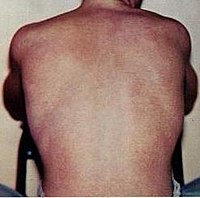
Photo from wikipedia
Risk maps of dengue disease offer to the public health officers a tool to model disease risk in space and time. We analyzed the geographical distribution of relative incidence risk… Click to show full abstract
Risk maps of dengue disease offer to the public health officers a tool to model disease risk in space and time. We analyzed the geographical distribution of relative incidence risk of dengue disease in a high incidence city from Colombia, and its evolution in time during the period January 2009—December 2015, identifying regional effects at different levels of spatial aggregations. Cases of dengue disease were geocoded and spatially allocated to census sectors, and temporally aggregated by epidemiological periods. The census sectors are nested in administrative divisions defined as communes, configuring two levels of spatial aggregation for the dengue cases. Spatio-temporal models including census sector and commune-level spatially structured random effects were fitted to estimate dengue incidence relative risks using the integrated nested Laplace approximation (INLA) technique. The final selected model included two-level spatial random effects, a global structured temporal random effect, and a census sector-level interaction term. Risk maps by epidemiological period and risk profiles by census sector were generated from the modeling process, showing the transmission dynamics of the disease. All the census sectors in the city displayed high risk at some epidemiological period in the outbreak periods. Relative risk estimation of dengue disease using INLA offered a quick and powerful method for parameter estimation and inference.
Journal Title: PLoS ONE
Year Published: 2018
Link to full text (if available)
Share on Social Media: Sign Up to like & get
recommendations!